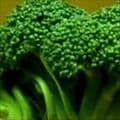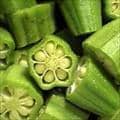Top 10 Vegetables Highest in Zinc

Zinc is an essential mineral forming a component of more than 300 enzymes in the body with functions including wound healing, immune system function, building proteins and DNA, fertility in adults and growth in children. Zinc is also needed for maintaining the senses of smell and taste.
A deficiency in zinc can lead to stunted growth, diarrhea, impotence, hair loss, eye and skin lesions, impaired appetite, and depressed immunity.
Conversely, consuming too much zinc can disrupt the absorption of copper and iron, as well as creating large amounts of toxic free radicals. It is easier to over-consume zinc from animal foods and supplements, from which it is more readily absorbed.
Vegans and vegetarians who primarily consume plant foods may have difficulty getting enough zinc, as zinc is not as bioavailable in plant foods as in animal foods. This is partly because beans and legumes contain phytates which can inhibit absorption. Despite this, plant foods are still a good source of zinc and there is no reason to eat meat or take a supplement.
The current daily value (DV) for zinc is 11mg, but vegetarians and vegans should aim to eat 30mg a day. Vegetables high in zinc include shiitake mushrooms, green peas, spinach, lima beans, lentil sprouts, asparagus, beet greens, broccoli, okra, and sweet corn.
Below is a list of high zinc vegetables ranked by common serving size, for more see the list of high zinc foods for vegans and vegetarians, high zinc fruits, and the nutrient ranking of 200 vegetables high in zinc.
List of Vegetables High in Zinc
 1 Shiitake Mushrooms
1 Shiitake Mushrooms| Zinc per Cup Cooked | Zinc per 100g | Zinc per 200 Calories |
|---|---|---|
| 1.9mg (18% DV) | 1.3mg (12% DV) | 4.8mg (43% DV) |
Other Mushrooms High in Zinc
- 12% DV zinc per cup of white button mushrooms
- 12% DV per cup of morel mushrooms
- 9% DV per cup of crimini mushrooms
 2 Green Peas
2 Green Peas| Zinc per Cup Cooked | Zinc per 100g | Zinc per 200 Calories |
|---|---|---|
| 1.9mg (17% DV) | 1.2mg (11% DV) | 2.8mg (26% DV) |
 3 Spinach
3 Spinach| Zinc per Cup Cooked | Zinc per 100g | Zinc per 200 Calories |
|---|---|---|
| 1.4mg (12% DV) | 0.8mg (7% DV) | 6.6mg (60% DV) |
 4 Lima Beans
4 Lima Beans| Zinc per Cup Cooked | Zinc per 100g | Zinc per 200 Calories |
|---|---|---|
| 1.3mg (12% DV) | 0.8mg (7% DV) | 1.3mg (12% DV) |
 5 Lentil Sprouts
5 Lentil Sprouts| Zinc per Cup Cooked | Zinc per 100g | Zinc per 200 Calories |
|---|---|---|
| 1.2mg (11% DV) | 1.5mg (14% DV) | 2.8mg (26% DV) |
More Sprouts High in Zinc
- 11% DV in 1 cup of pea sprouts
- 9% DV in 1 cup of cooked soybean sprouts
- 5% DV in 1 cup of mung bean sprouts
 6 Asparagus
6 Asparagus| Zinc per Cup Cooked | Zinc per 100g | Zinc per 200 Calories |
|---|---|---|
| 1.1mg (10% DV) | 0.6mg (5% DV) | 5.5mg (50% DV) |
 7 Beet Greens
7 Beet Greens| Zinc per Cup Cooked | Zinc per 100g | Zinc per 200 Calories |
|---|---|---|
| 0.7mg (7% DV) | 0.5mg (5% DV) | 3.7mg (34% DV) |
 8 Broccoli
8 Broccoli| Zinc per Cup Cooked | Zinc per 100g | Zinc per 200 Calories |
|---|---|---|
| 0.7mg (6% DV) | 0.5mg (4% DV) | 2.6mg (23% DV) |
 9 Okra
9 Okra| Zinc per Cup Cooked | Zinc per 100g | Zinc per 200 Calories |
|---|---|---|
| 0.7mg (6% DV) | 0.4mg (4% DV) | 3.9mg (36% DV) |
 10 Sweet Corn
10 Sweet Corn| Zinc per Cup Cooked | Zinc per 100g | Zinc per 200 Calories |
|---|---|---|
| 0.7mg (6% DV) | 0.5mg (4% DV) | 1.1mg (10% DV) |
Printable One Page Sheet

About the Data
Data for the curated food lists comes from the USDA Food Data Central Repository.
You can check our data against the USDA by clicking the (Source) link at the bottom of each food listing.
Note: When checking data please be sure the serving sizes are the same. In the rare case you find any difference, please contact us and we will fix it right away.
About Nutrient Targets
Setting targets can provide a guide to healthy eating.
Some of the most popular targets include:- Daily Value (%DV) - The daily value (%DV) is a general guideline for consumption that will prevent deficiency of a particular nutrient in most people. The %DV refers to the percentage of an amount that's found in a single serving of a food. It also accounts for absorption factors. It is set by the U.S. FDA.
- Recommended Dietary Allowance (%RDA) - The RDA sets an average daily dietary intake level that is sufficient to meet the nutrient requirements of nearly all (97.5%) healthy individuals. It's more specific than the daily value, and varies by age and gender. The RDA is set by the US National Instutites of Health.
- Reference Dietary Intake (%RDI) -The reference dietary intake is similar to the recommended daily allowance, but is specific to age and gender. The RDI for amino acids is set by the U.N. World Health Organization.
- Adequate Intake (%AI) - This value is primarily used in reference to omega-3 and omega-6 fats. The Adequate Intake is set by the U.S. Institute of Medicine. Because there is less evidence to determine the ideal targets for consumption of these nutrients, the specific amount is considered to be less reliable. Using the term Adequate Intake, rather than one of the other terms, helps to emphasize that the ideal intake of that particular nutrient has not yet been scientifically determined.
See the Guide to Recommended Daily Intakes for more information.
Want to set your own targets? Sign up for an account and set custom targets in the daily meal planner.From the Nutrient Ranking Tool
Use the ranking tool links below to select foods and create your own food list to share or print.
- Foods High in Zinc
- Foods Low in Zinc
- Vegetables High in Zinc
- Fruits High in Zinc
- Vegetarian Foods High in Zinc
- Nuts High in Zinc
- Grains High in Zinc
- Beans High in Zinc
- Dairy High in Zinc
- Breakfast Cereals High in Zinc
- Fast Foods High in Zinc
View more nutrients with the nutrient ranking tool, or see ratios with the nutrient ratio tool.
Related
Data Sources and References
Try the recipe nutrition calculator, or daily meal planner.
Create a free account to log and track foods.
